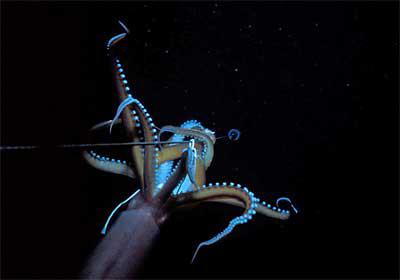The large deepsea squid shown above triggered its own photograph on a special undersea camera used by Antartic Division scientists during their last expedition to Heard Island, and mimics the movements of the true Giant Squid which was photographed for the first time recently by Japanese scientists. Hobart-based Liz Turner, Curator of Invertebrate Zoology at the Tasmanian Museum in Hobart, Rosny Collections and Research Facility, says “For the world to be able to see the photographs of a live Giant Squid is a huge leap in the quest for knowledge about these gargantuans of the oceans”.
Here she talks about some aspects of the life and times of an animal which was known to exist from dead specimens washed up (many times on Tasmanian beaches) but never seen alive in its natural habitat deep in the ocean until now:
Giant Squid (Architeuthis sp), belong to a group of molluscs known as the Cephalopoda. They occur in deep, cool temperate waters around the world. Known to grow to a length of up to 20 metres, they can weigh a huge amount. The heaviest specimen dissected by the Tasmanian museum staff weighed 255kg — and that was without the long feeding tentacles.
Giant Squid feed with a heavily armed tongue/rasp (radula), and breathe with feathery gills. They have eight arms, two feeding tentacles, and a gladius or ‘pen’ that extends the length of the mantle. They have suckers along the arms and on the clubs at the ends of the tentacles. These are not very large, being about the size of a 10 cent coin along the arms, and maybe a 20 cent coin on the clubs. All suckers have horny toothed rims and are small in comparison to the overall size of the animals, but what they lack in size they make up in numbers.
Pursuit carnivores
Giant Squid are called pursuit carnivores, hunting deepwater squid, fish and probably other animals. They have a parrot-like beak that tears prey to pieces because it has be swallowed down a very narrow esophagus or ‘throat’ to reach the stomach. Their muscles are full of ammonia. This is used to give the animal buoyancy and therefore the bodies of Giant Squids washed up or trawled have an extremely pungent smell. It also makes them inedible. Not at all good for supersize calimari, although a lot of people make that joke.
Giant Squid have the largest eyes in the world, but microscopic ears in comparison. Dissecting the large fleshy head to uncover these tiny organs is like looking for a needle in a haystack, cutting away in tiny little slices until each ear is exposed — it might take up to half-an-hour of very slow work.
Jet propulsion
Also small in comparison to the overall size is the statocyst, an organ in the head that helps the animal keep its balance and tell whether it’s upside down or the right way up. It can also distinguish the water pressure, accurately alerting the squid to the depth it’s at — because lessening pressure is as dangerous to the squid as the increasing pressure is to us when we venture deep under the sea’s surface. Cephalopods move by flapping fins and by jet propulsion. Although able to cruise slowly, they can produce bursts of speed to avoid danger or capture prey. There is no reason to presume that the Giant Squid is any different. Like most species of squid and octopus, female Giant Squid spawn and then die; scientists believe this may be after only three years of life.
Many more questions
A great many questions remain to be answered about squids’ mating. However, it is known that the male Giant Squid produces packages of sperm which he passes to the female with a specialised arm. During dissections, staff at the Tasmanian Museum have observed these packages usually stored under the skin of the arms or the mantle of females — waiting to be fertilised when situations are suitable.
I’ve seen seen hundreds of thousands of tiny eggs in the ovary of a dissected female. In fact, when at times some spilled out on to the floor it was walking on tapioca. We don’t really know how Giant Squid can grow so big in such a remarkably short time, just two to three years. Because they live in very deep water it’s been impossible to research them, but now it has proved possible to capture them on film, this and other questions may be answered.
Photographer and author unknown. Text taken from an article on Leatherwood Online for my own research purposes only.

